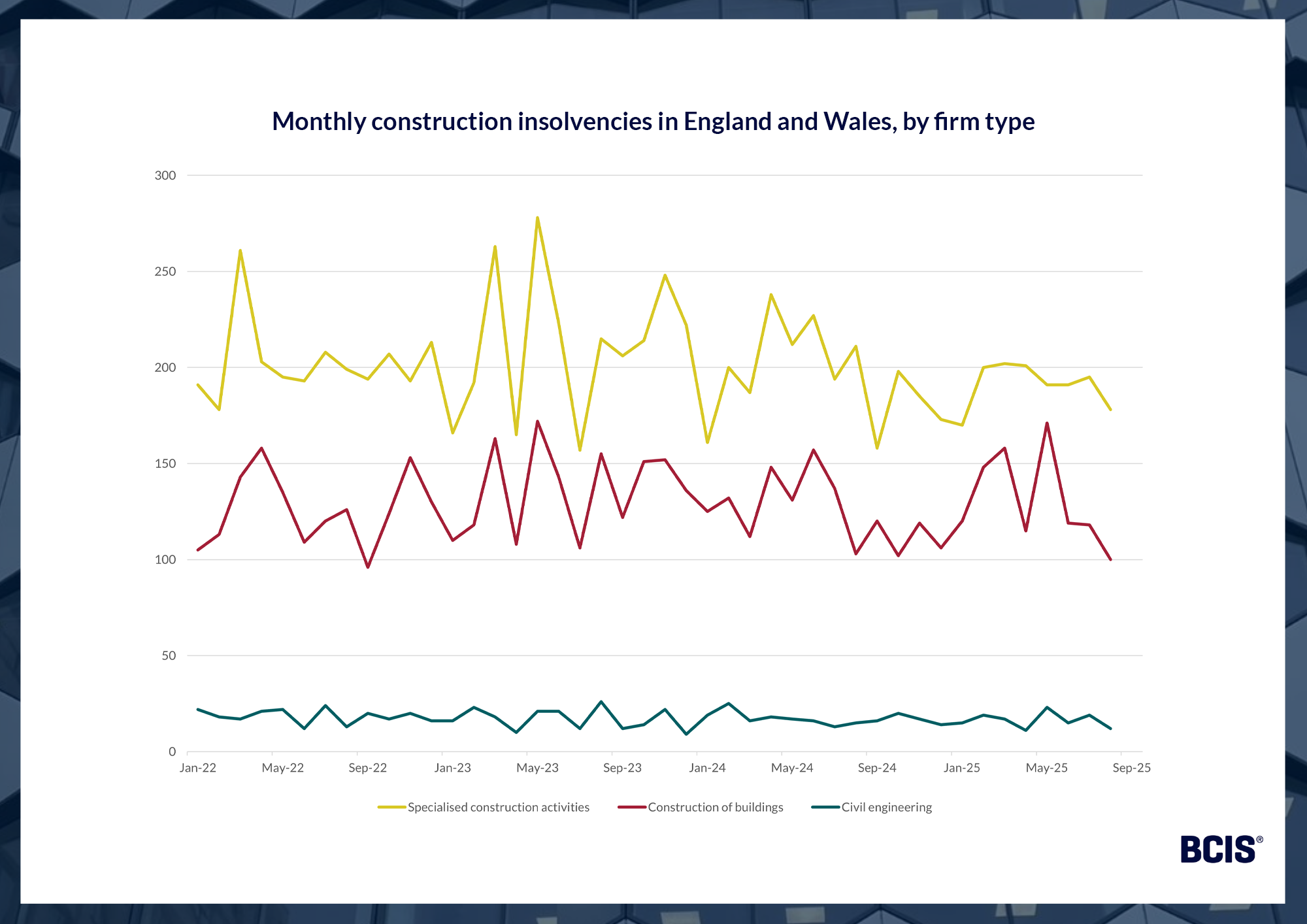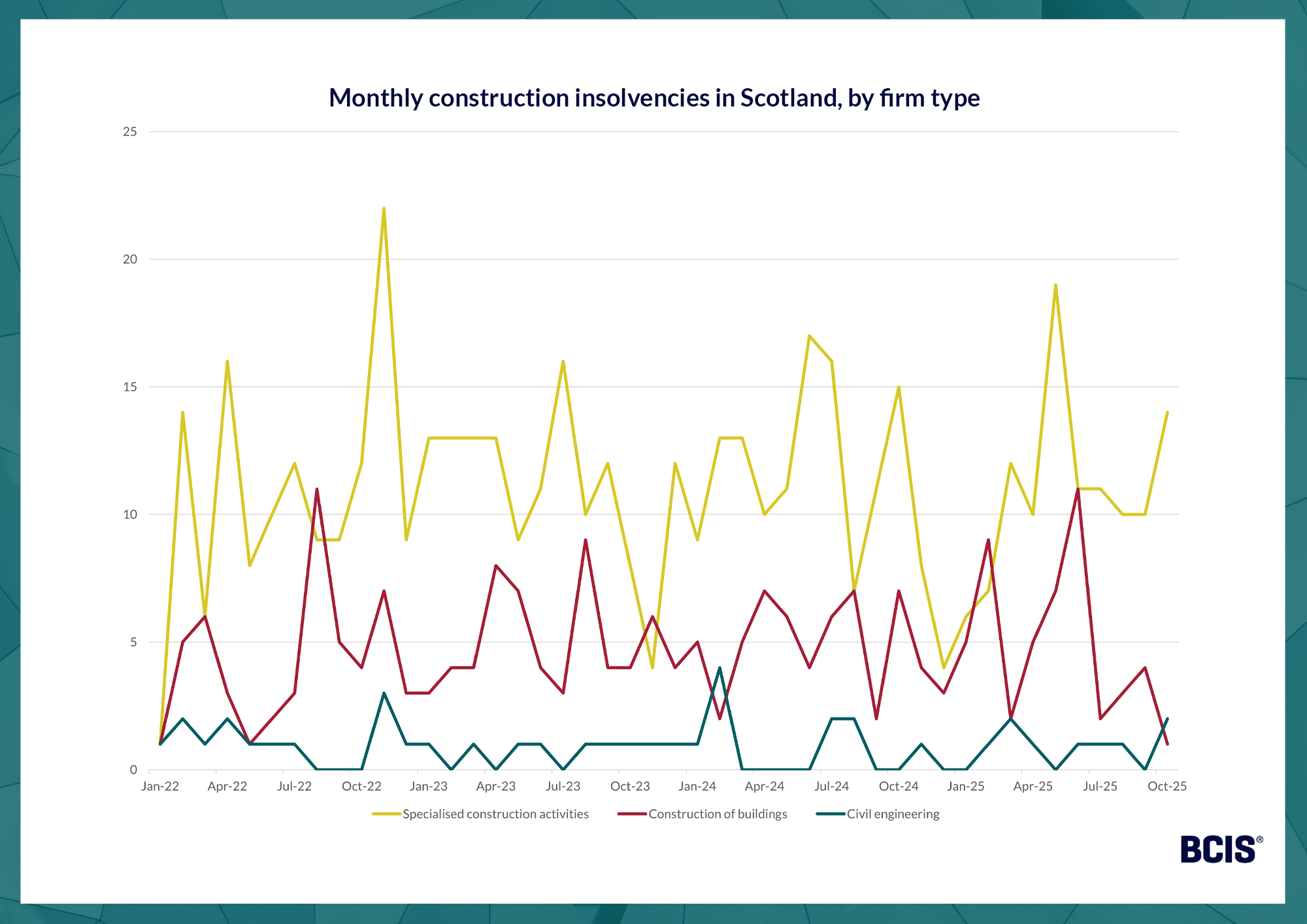BCIS CapX includes price adjustment formulae, a method of calculating the increase, or decrease, in contractors’ costs over any period. The formulae and indices (over 200 of them) are widely used in various sectors in the construction industry, including civil engineering contracts and facility management.
Published: 20/11/2025
Construction firms accounted for 15.2% of all insolvencies in England and Wales in September 2025, according to The Insolvency Service(1), with 291 registered construction businesses becoming insolvent.
This was just one more than had been recorded in August, and was three fewer than the 294 in September 2024.
By rough comparison, construction firms accounted for 14%(2) of all registered businesses in the UK as of March 2025.
The largest proportion of construction insolvencies were among firms providing specialised construction activities with 169 recorded in September – nine fewer than were seen in August.
The total number of construction firms becoming insolvent in the 12 months to the end of September 2025 was 3,933. This was an 8% decrease on the 4,276 insolvencies recorded in the year ending in September 2024, and a 22% increase on the 3,221 in pre-pandemic 2019.
Source: The Insolvency Service
Of all cases where the industry was captured in the statistics, construction again experienced the highest number of insolvencies in the year to September 2025.
The Insolvency Service said while the insolvency rate has increased since the lows seen in 2020 and 2021, it remains much lower than the peak of 113.1 per 10,000 companies seen during the 2008-09 recession. This is because the number of companies on the effective register has more than doubled over this period. The rate in the year to the end of October 2025 was 53.4 per 10,000 companies(3).
In Scotland, there were 17 construction company insolvencies in October 2025, three more than were recorded in September 2025, and accounting for 14.8% of all insolvencies in the country.
The number of Scottish construction insolvencies for the 12-month period to September 2025 was 188. This was a 10.5% decrease on the 210 recorded in the year to October 2024 and a 9% decrease on the 207 in pre-pandemic 2019.
Source: The Insolvency Service
Within the industry, firms classified as providing specialised construction activities are consistently the most affected across Great Britain. However, analysis shows that their numbers are proportional to their overall share within the construction sector.
This category includes companies providing a range of work, typically on a subcontract basis, from demolition and site preparation to electrical and plumbing installation, and finishing work like plastering, painting and glazing.
The Insolvency Service also publishes figures for Northern Ireland, but not with sector breakdowns.
Analysis by EY-Parthenon(4) on profit warnings issued by listed construction companies has shown particular vulnerabilities in the industry.
It revealed over half of companies in the FTSE household goods and home construction sector issued profit warnings in 2024.
Reflecting on all sectors in 3Q2025, it reported: ‘UK-listed companies issued 64 profit warnings in Q3 2025, slightly above Q2 (59) but well below last year’s peak (84). A steadier number of warnings suggests that many of 2025’s economic and geopolitical pressures are now priced into earnings forecasts, but risks continue to evolve.
‘The broader economic backdrop is still fragile, with restructuring activity increasing as firms face tighter liquidity and reduced flexibility. If this is a pause in profit warnings, it’s an uneasy one.’
According to the report, six profit warnings were issued by FTSE construction and materials companies in 3Q2025, bringing the sector total for 2025 to 14.
Residential market weakness, commercial uncertainty, budget constraints, and delays caused by new safety regulations were among the contributing challenges behind the sector’s warnings in 3Q2025.
A multitude of factors feed into company insolvency, though analysis of profit warning data by EY suggests the construction industry is particularly exposed to financial difficulty. This is in part due to the nature of contract cycles and the challenges of cash flow management that contractors and subcontractors are subject to.
Further data(5) released by The Insolvency Service showed that 288, or 25%, of self-employed or trader bankruptcies in the 12 months to August 2025 were in construction in England and Wales.
An effective way of mitigating the risks associated with fixed-price contracts when costs are so changeable is to use fluctuation clauses linked to work category and resource-specific inflation indices, such as those available in BCIS CapX.
Our Price Adjustment Formulae Indices (PAFI), covering more than 200 work activities across building, civil engineering, specialist engineering and highways maintenance, can also be used throughout the budgeting and procurement stages to plan cash flow more effectively.
To keep up to date with the latest industry news and insights from BCIS, register for our newsletter here.
(1) GOV.UK – Company insolvencies, October 2025 - here
(2) Office for National Statistics – UK business; activity, size and location: 2025 - here
(3) GOV.UK Commentary – Commentary – Company Insolvency Statistics October 2025 - here
(4) EY-Parthenon – Analysis of UK Profit Warnings - here
(5) GOV.UK – Commentary – Individual insolvencies, October 2025 – here


